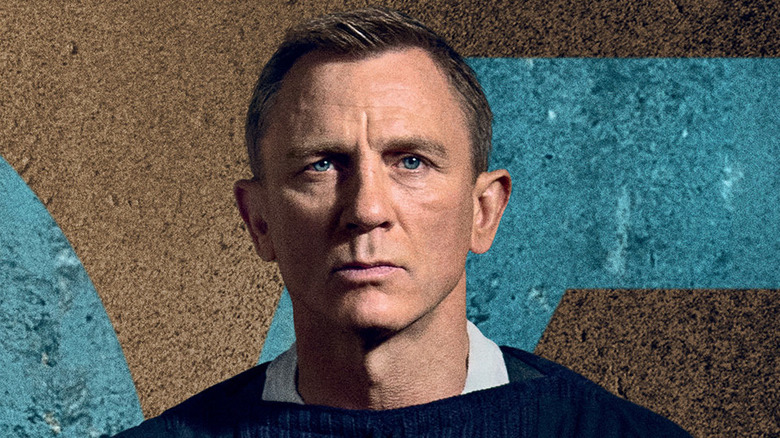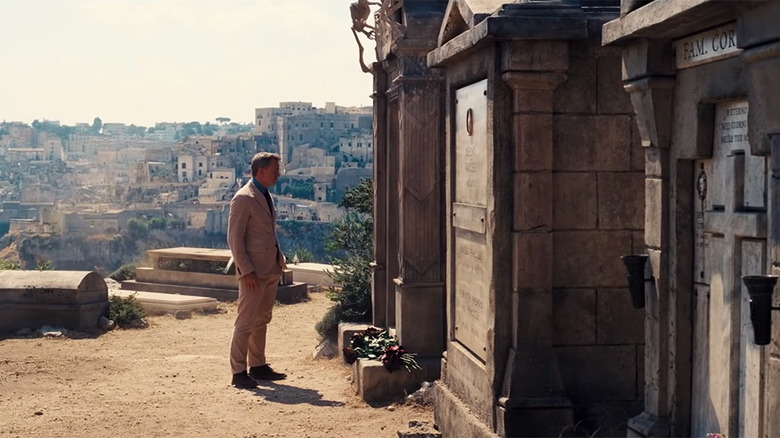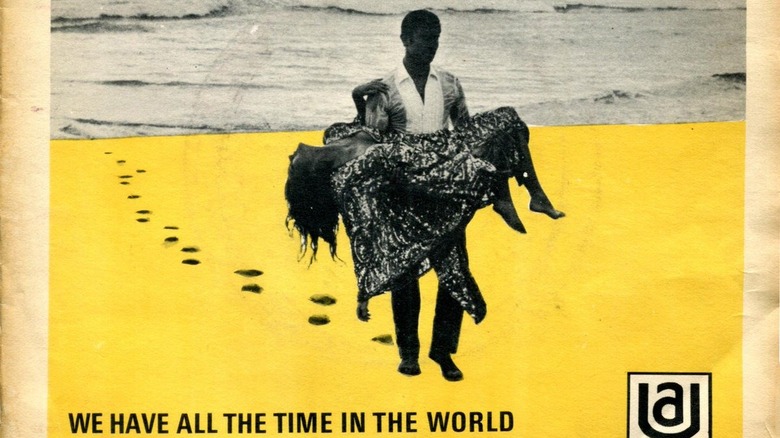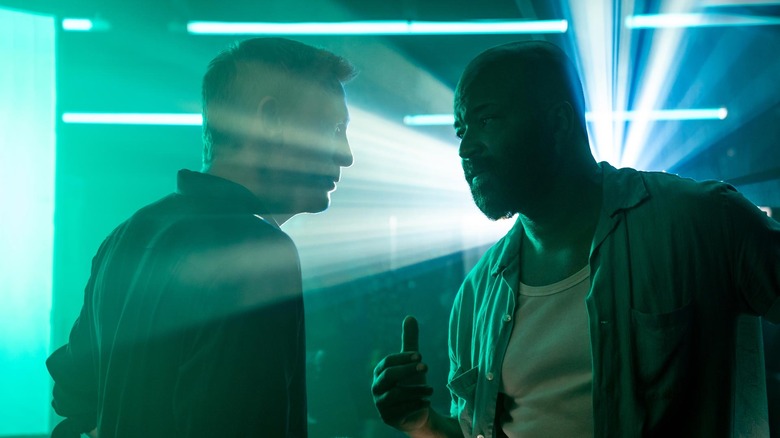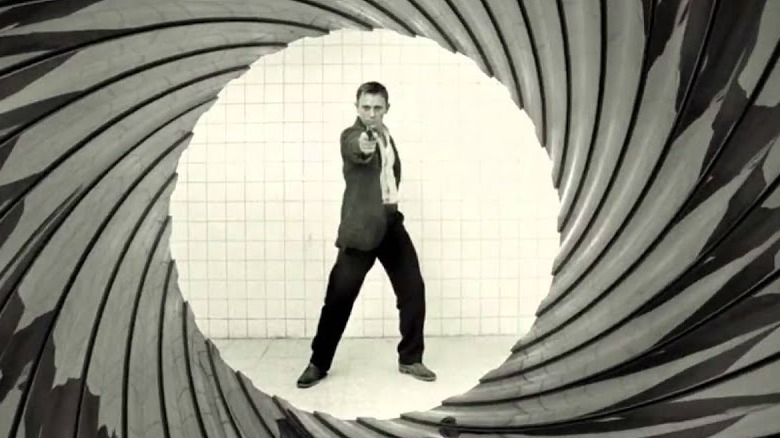Small Details You Missed In No Time To Die
Spoiler warning: This article contains major plot details for "No Time to Die."
With a franchise as storied and rich in its history as the James Bond series, new entries into the oeuvre always come with a fair share of interesting details. Sometimes these are Easter eggs, blink-and-you'll-miss-it touches calling for the attention of eagle-eyed fans familiar with the larger tapestry every new Bond actor and Bond director bring to the table to honor those who came before them. But sometimes, those details are more than just fan service.
"No Time to Die," in particular, brings a lot of texture and George Lucas-level rhyming to its larger narrative. It's a layered film that concludes Daniel Craig's five-film tenure as 007 and the internal lore of his ongoing saga while drawing from ideas, imagery, and themes from the series as a whole.
Director Cary Joji Fukunaga helped craft the script with Phoebe Waller-Bridge, alongside franchise mainstays Neal Purvis and Robert Wade. But between juggling the film's central romance, its plot-heavy throughline, and its many action set pieces, everyone involved tucked away a number of fascinating and mind-blowing details that'll make for rewarding rewatches in the future. Here's a look at a few you may have missed.
You only make the same mistake twice
Early in "No Time to Die," before we get to hear the dulcet tones of Billie Eilish's Grammy-winning theme song, Daniel Craig's Bond is forced to come to terms with lingering pain that has haunted him since his debut in "Casino Royale."
At the end of that film, Bond discovered the woman he had fallen in love with, Vesper Lynd (Eva Green), had betrayed him. It was a formative sort of heartbreak that set in stone the granite at his core, the reason he remained so cold to any new suitors in subsequent films. But when we last saw him in "Spectre," he was riding off into a nebulous ever after with Dr. Madeleine Swann (Léa Seydoux), a woman he was ready to spend the rest of his life with.
As "No Time to Die" begins, Madeleine asks Bond to forgive Vesper, to visit her grave and, in keeping with a local tradition, write her a final message on paper and burn it. When he arrives, he makes his peace with the betrayal (especially understanding the motivation behind it from "Quantum of Solace"), writing the words "forgive me" before lighting them ablaze. But then a fire of a different sort erupts as Vesper's grave explodes, setting the film into motion.
Bond is convinced that Madeleine, just like Vesper, must have played his emotions to bring him into this trap, and after a lengthy car chase and multiple shootouts, the two split for good, with Bond telling Madeleine he'll never see her again. It all turns out to be a trick played by Blofeld (Christoph Waltz), who knew how Bond would react. He was once again serving as the author of all of James' pain, preying on his weakness, his inability to trust, to doom him forever.
It's a tragic mistake for Bond, because five years pass and by the time Bond and Madeleine reunite and bury the hatchet, he's missed out on the daughter he didn't know he sired. Once they're ready to be a family and ride off into the sunset, Bond has to sacrifice himself to save them both, as well as the world.
It's the most tragic ending to a Bond film since, well...
All the time in the world...
1969's "On Her Majesty's Secret Service" was the last Bond film to genuinely give Bond hope for true love, in the form of Countess Tracy di Vicenzo (Diana Rigg). That film famously ended with a shocking and heartbreaking death, but Tracy and Madeleine have quite a bit in common.
Like Madeleine, Tracy was first introduced to Bond as the daughter of one of the film's villains, Marc-Ange Draco (Gabriele Ferzetti.) Also as with Madeleine and Bond, Tracy and Bond's initial intermingling during a mission transformed into true love. But in "On Her Majesty's Secret Service," that romance leads to a marriage that sadly ends with Blofeld (Telly Savalas) having Tracy murdered, right by Bond's side.
That unforgettable doomed romance has haunted Bond fans for decades, so going into "No Time to Die" it was natural to worry Madeleine might face the same fate Tracy once did. The film itself makes countless references to "On Her Majesty's Secret Service," particularly through homaging Louis Armstrong's "We Have All the Time in the World" theme in the score, as well as having the line echoed — but this time rather than Bond saying it to Tracy right before her vicious murder, it's Bond saying it to Madeleine as he prepares to sacrifice himself in the film's climax.
It's a reversal sure to wet every eye in the house, but in a way, it's a touching turnabout. Tracy's death held such a pall over the franchise that it affected Sean Connery's Bond when he returned to the franchise in "Diamonds Are Forever." But here, with Craig hanging up the tux for good, Bond doesn't have to survive losing the love of his life. He's able to die serving something larger than himself, allowing that love and the child they made together to endure.
Guess who's coming to dinner...
On a lighter note, "No Time to Die" reveals something new about one of the franchise's most beloved characters. As is common with Craig's iteration of Bond, there is a point in the film's second act when he must go rogue, disobey his orders from M (Ralph Fiennes), and enlist the help of Q (Ben Whishaw) in better understanding the film's MacGuffin, Project Heracles.
But when Bond and Moneypenny (Naomie Harris) barge in on Q after hours at his home, he's in the middle of preparing dinner for an unnamed guest. Given Q's nervousness and general flustered attitude about finishing this dinner and not being interrupted by Bond's shenanigans, it stands to reason the guest in question is a romantic partner of some sort. When Bond and Moneypenny give him some playful ribbing about who he's getting so fancy for, he remarks that he will be here any minute, implying Q is not straight.
Where exactly he lies on the sexual orientation spectrum is left unspecified, obviously, but alongside the film's overall better treatment of its female characters, including casting Lashana Lynch, a Black woman, as Bond's 007 replacement Nomi, the casual assertion that Q is queer is a charming bit of onscreen representation. It bears no heavy impact on the plot, but it's snuck in admirably matter-of-factly.
Good for Q! But, well, bad for his date, who certainly didn't get the full course meal he was anticipating, since his partner had to do a bunch of hacking for a superspy.
A tale of two brothers
While the Daniel Craig iteration of James Bond is canonically an orphan and an only child, "No Time to Die" features him watching two of his brothers die, with very different reactions.
In "Spectre," we witnessed the controversial choice to retcon the Christoph Waltz version of Blofeld to be Bond's adopted brother, the son of a man who took James in at a young age. It adds an extra twinge of pathos to their feud, but it goes largely under-explored in that film and this one, beyond continuing Blofeld's ominous speeches about his machinations and grudges. So it's no surprise that when Bond, while overcome with rage and choking Blofeld through prison bars, unknowingly exposes his nemesis to the nanobot bioweapon that will take his life, his reaction is mild to say the least.
But he loses another brother earlier in the film: Felix Leiter (Jeffrey Wright), the CIA operative who introduced himself all the way back in "Casino Royale" as "a brother from Langley." Though much of their relationship has taken place offscreen with Leiter not appearing in "Skyfall" or "Spectre," given the amount of time that has passed in the franchise's world, we know Bond and Leiter were close. They weren't just work friends, but rather brothers in arms who had clearly experienced a lot, on the job and off. Leiter was one of the only people in these films who could genuinely call Bond a friend, so the brother designation is not far off.
Leiter and Bond wind up on a sinking ship, with Leiter suffering from gunshot wounds at the hands of Logan Ash (Billy Magnusson), a fellow CIA officer who betrayed them both. The final moments they share, as they both have to accept Leiter will never make it off this boat, is a much richer and more affecting death, even if Craig's subtle work with the character means both reactions, on the surface, become hard to read past his steely gaze.
But there's a lot of death in "No Time to Die." None bigger than the last one...
Staring down the barrel
The iconic shot of James Bond turning to the camera, itself mimicking the perspective of a gun barrel, has featured prominently throughout the franchise, often as part of the opening credits sequence. In "No Time to Die," this bit of nostalgic imagery plays into one of the movie's most affecting moments.
In the film's final act, as Bond and Nomi descend on Safin's island headquarters, the duo have to split up so Nomi can get Madeleine and Mathilde to safety. By this point in the movie, it's becoming more obvious to the viewer that this is the first Bond film where he really might not make it out alive. It's the layering of references to death, the losses he suffers early on, and just the general sense of dread Fukunaga weaves into his compositions and staging.
But when Bond is stalking down a hall and turns to us, gun pointing, the shape, positioning and texture of the surrounding walls mimic the gun barrel shot we all know and love. It doesn't read like a fun shoutout, however.
The way Bond is shrunken in the frame, he seems a small figure emasculated by the enveloping shroud of death that surrounds the whole island — and really this whole film. It feels like one last look back — at the past, at the viewer — before he trudges on to meet his tragic fate.
It's one of the most haunting moments in any Bond film ever made, and is sure to be an enduring image burned into the collective consciousness as Craig's time with the character has finally come to an end.
